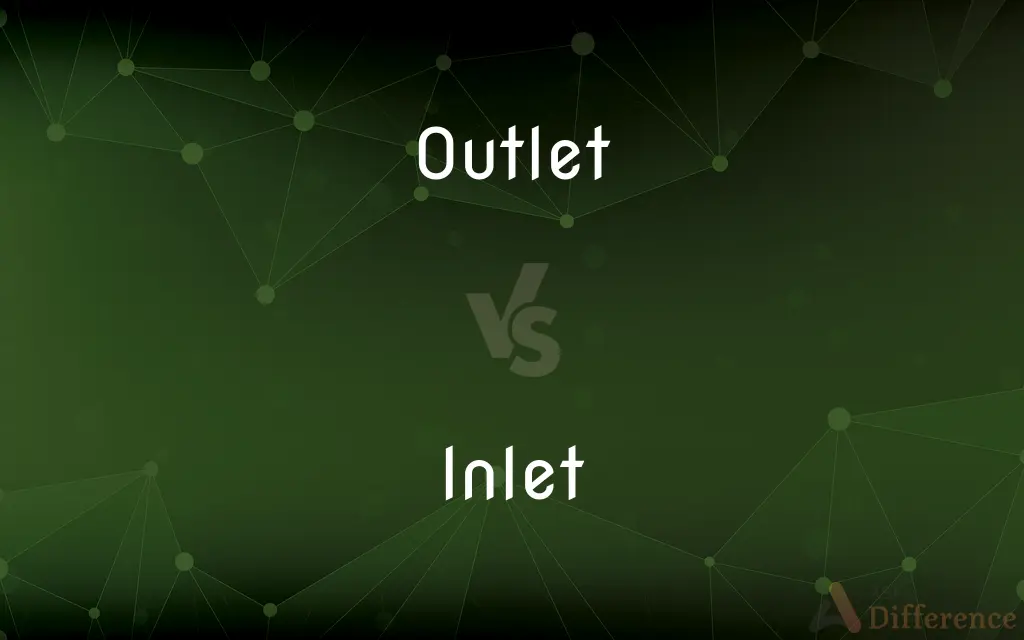Outlet vs. Inlet — What's the Difference?
By Tayyaba Rehman & Urooj Arif — Updated on March 17, 2024
An outlet is an exit point for substances or electricity, whereas an inlet is an entry point, often referring to water bodies or air intake.

Difference Between Outlet and Inlet
Table of Contents
ADVERTISEMENT
Key Differences
An outlet serves as a point from which substances like water, air, or electricity can exit or be discharged from a system. It is commonly associated with electrical sockets, water drainage, or exhaust vents. On the other hand, an inlet refers to an entrance through which substances, particularly water or air, can enter into a larger body or system. In geographical terms, an inlet is often a narrow body of water between islands or leading inland from a larger body of water, sometimes also referred to as a bay or cove.
Outlets in electrical systems are points where appliances and devices can connect to the electrical grid to draw power. In contrast, inlets can be found in various systems, including cooling systems where air is drawn into the system, or in geographical features where water flows from the sea into the land.
The design and function of outlets are crucial for the effective removal or release of substances from a system, ensuring safety and efficiency, such as in the case of electrical outlets that are designed to connect devices to the power supply safely. Inlets, however, are designed to facilitate the smooth entry of substances, such as air inlets in engines that ensure efficient airflow for combustion or sea inlets that can serve as natural harbors.
While outlets are often designed to control or regulate the discharge of substances, ensuring that it occurs in a safe, controlled manner, inlets are designed to maximize the efficient entry or collection of substances, such as water inlets in irrigation systems that maximize water flow into the system.
Despite their opposite functions, both outlets and inlets are essential components of various systems, facilitating the controlled movement of substances into and out of systems, whether it be in mechanical systems, natural water bodies, or electrical grids.
ADVERTISEMENT
Comparison Chart
Definition
An exit point for substances or electricity
An entry point for substances, particularly water or air
Common Uses
Electrical sockets, water drainage, exhaust systems
Water bodies leading inland, air intake systems
Function
To discharge or release substances from a system
To allow substances to enter into a system or area
Design
Designed to safely connect devices or manage discharge
Designed to facilitate the smooth entry or collection of substances
Significance
Crucial for safety and efficiency in various systems
Important for maximizing efficiency and utility of systems
Compare with Definitions
Outlet
Provides access to electrical power.
The laptop was plugged into the wall outlet for charging.
Inlet
Introduces air into a system, like an engine.
The engine's performance is optimized by its air inlet design.
Outlet
Serves as a discharge point for water.
The outlet of the bathtub was clogged with hair.
Inlet
Allows water to flow into a land area.
The scenic inlet was a popular spot for kayakers.
Outlet
Acts as an exit for exhaust or waste gases.
The car's exhaust system has a carefully designed outlet.
Inlet
Can serve as a natural harbor for boats.
The small fishing boats were anchored safely in the inlet.
Outlet
Outlets control the flow of substances out of a system.
The dam's outlets are opened periodically to control water levels.
Inlet
Designed for efficient substance entry.
The cooling system's inlet ensures adequate airflow for heat dissipation.
Outlet
Outlets are designed to ensure safe discharge.
Electrical outlets are equipped with safety features to prevent shocks.
Inlet
Acts as a water source for irrigation systems.
The inlet channel supplies water to the entire irrigation system.
Outlet
A passage for escape or exit; a vent.
Inlet
An inlet is an indentation of a shoreline, usually long and narrow, such as a small bay or arm, that often leads to an enclosed body of salt water, such as a sound, bay, lagoon, or marsh.
Outlet
A means of release or gratification, as for energies, drives, or desires
Exercised as an outlet for frustration.
Inlet
A small arm of the sea, a lake, or a river.
Outlet
A stream that flows out of a lake or pond.
Inlet
A place or means of entry
An air inlet
Outlet
The point where a stream flows out of a lake or pond.
Inlet
(chiefly in tailoring and dressmaking) a piece of material inserted into a garment.
Outlet
The mouth of a river where it flows into a larger body of water.
Inlet
A recess, such as a bay or cove, along a coast.
Outlet
The point of intersection of a driveway and a road, especially in a rural area.
Inlet
A stream or bay leading inland, as from the ocean; an estuary.
Outlet
A commercial market for goods or services.
Inlet
A narrow passage of water, as between two islands.
Outlet
A store that sells the goods of a particular manufacturer or wholesaler.
Inlet
A drainage passage, as to a culvert.
Outlet
A receptacle, especially one mounted in a wall, that is connected to a power supply and equipped with a socket for a plug.
Inlet
An opening providing a means of entrance or intake.
Outlet
A vent or similar passage to allow the escape of something.
Inlet
(transitive) To let in; admit.
Outlet
Something which allows for the release of one's desires.
Jamie found doing martial arts was a great outlet for her stress.
Inlet
(transitive) To insert; inlay.
Outlet
A river that runs out of a lake.
Inlet
(firearms) To carve the wooden stock of a firearm so as to position the metal components in it.
Outlet
A shop that sells the products of a particular manufacturer or supplier.
Inlet
A body of water let into a coast, such as a bay, cove, fjord or estuary.
Outlet
A wall-mounted device such as a socket or receptacle connected to an electrical system at which current is taken to supply utilization equipment or appliances.
I had to move the cupboard to get to the power outlet.
Inlet
A passage that leads into a cavity.
Outlet
The place or opening by which anything is let out; a passage out; an exit; a vent.
Receiving all, and having no outlet.
Inlet
A passage by which an inclosed place may be entered; a place of ingress; entrance;
Doors and windows, inlets of men and of light.
Outlet
To let out; to emit.
Inlet
A bay or recess, as in the shore of a sea, lake, or large river; a narrow strip of water running into the land or between islands.
Outlet
A place of business for retailing goods
Inlet
That which is let in or inlaid; an inserted material.
Outlet
Receptacle providing a place in a wiring system where current can be taken to run electrical devices
Inlet
An arm off of a larger body of water (often between rocky headlands)
Outlet
An opening that permits escape or release;
He blocked the way out
The canyon had only one issue
Outlet
Activity that releases or expresses creative energy or emotion;
She had no other outlet for her feelings
He gave vent to his anger
Common Curiosities
Are inlets safe to swim in?
Safety in swimming in inlets depends on local conditions, such as water currents and tides, and should be approached with caution.
Are there environmental concerns associated with outlets and inlets?
Yes, the placement and management of outlets and inlets, especially those related to water, can have significant environmental impacts, affecting local ecosystems and water quality.
Can the function of an inlet affect an engine's performance?
Yes, the design and efficiency of an air inlet in an engine can significantly impact the engine's performance, affecting airflow and combustion efficiency.
How do outlets affect electrical safety?
Outlets are designed with safety features like grounding and circuit breakers to prevent electrical hazards and ensure safe use of electrical devices.
How do you clean an electrical outlet safely?
To clean an electrical outlet, first ensure the power is turned off at the breaker. Use a dry, soft brush to gently remove debris, and avoid using liquids or sprays that could cause an electrical hazard.
How do inlets affect local ecosystems?
Inlets can provide critical habitats for various marine and freshwater species, supporting biodiversity, but they can also be vulnerable points for pollution and human impact.
Can an improperly installed outlet pose risks?
An improperly installed outlet can pose significant risks, including fire hazards, electrical shocks, and damage to appliances, underscoring the importance of professional installation and adherence to safety standards.
What measures can prevent pollution in natural inlets?
Preventing pollution in natural inlets involves measures such as regulating industrial discharges, promoting sustainable land use practices, and implementing effective waste management strategies to protect water quality.
Can an outlet also serve as an inlet?
In some systems, a component might serve dual functions under different conditions, but typically outlets and inlets are designed for specific, unidirectional flow.
Can inlets create environmental hazards?
Inlets can potentially create environmental hazards if they introduce polluted water or foreign substances into an ecosystem, disrupting local habitats and water quality.
What is the importance of outlet covers in homes with children?
Outlet covers are crucial in homes with children to prevent electrical shock and deter small children from inserting objects into outlets, enhancing household safety.
How does the size of an inlet affect an HVAC system's efficiency?
The size of an inlet in an HVAC system affects its efficiency by influencing airflow; an inadequately sized inlet can restrict airflow, reducing system efficiency and increasing energy consumption.
Are there regulations governing the placement of outlets and inlets?
Yes, there are regulations and building codes that govern the placement, design, and safety features of outlets and inlets to ensure public safety and environmental protection.
How does the design of a car's air inlet affect fuel efficiency?
The design of a car's air inlet affects fuel efficiency by optimizing the air-to-fuel ratio in the combustion process, leading to more efficient engine performance and reduced fuel consumption.
How do inlets contribute to water circulation in lakes and ponds?
Inlets contribute to water circulation in lakes and ponds by introducing fresh water, which can help distribute nutrients, regulate temperature, and support aquatic life.
Share Your Discovery

Previous Comparison
Sacristy vs. Vestry
Next Comparison
Hostility vs. AggressionAuthor Spotlight
Written by
Tayyaba RehmanTayyaba Rehman is a distinguished writer, currently serving as a primary contributor to askdifference.com. As a researcher in semantics and etymology, Tayyaba's passion for the complexity of languages and their distinctions has found a perfect home on the platform. Tayyaba delves into the intricacies of language, distinguishing between commonly confused words and phrases, thereby providing clarity for readers worldwide.
Co-written by
Urooj ArifUrooj is a skilled content writer at Ask Difference, known for her exceptional ability to simplify complex topics into engaging and informative content. With a passion for research and a flair for clear, concise writing, she consistently delivers articles that resonate with our diverse audience.
















































